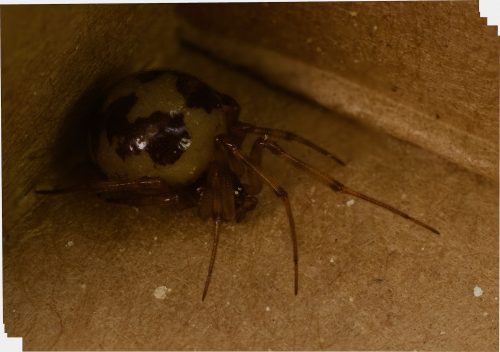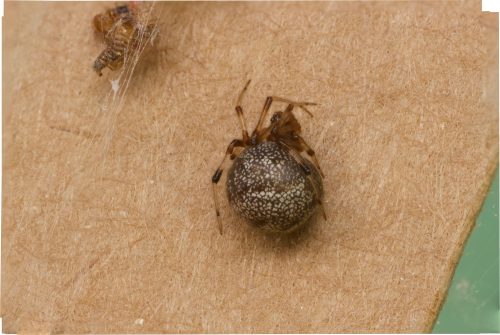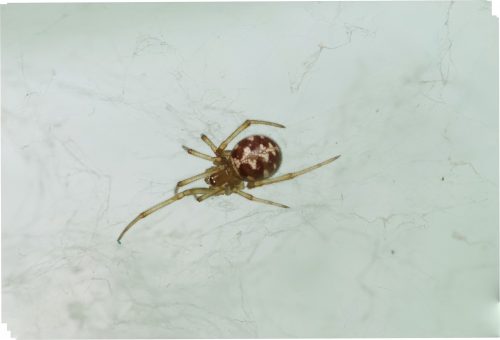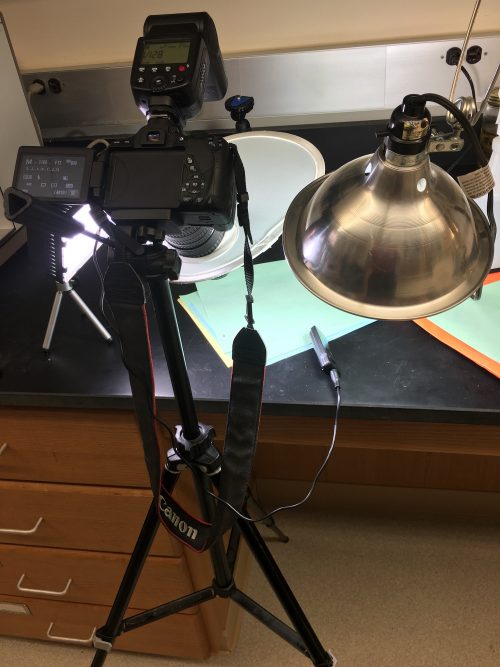Some people mentioned I should try focus stacking on my spiders, so I fumbled around and found some inexpensive software to do it, and gave it a shot. Here are a couple of trial runs (including some spiders I photographed in a single plane yesterday.
I’m just going to say…nice. Also easy. I always take multiple shots anyway, so I just do what I always do, maybe being a little more careful about centering each shot as identically as I can, and then dumping 4-8 photos into the software. I especially like how the juvenile in the third image turned out, letting me see individual hairs on the legs while not compromising the sharpness of the abdominal pigment pattern.
A few words about how I’m doing this: this is my Spider Studio.
It’s nothing fancy, as you can see. I’ve got a Canon body and a speedlite; I’m using my lovely Tokina macro 100mm lens, with a couple of tube extenders for extra magnification, and there’s also a big white diffuser there. I’ve got a bright LED panel to the left and back, and a simple clamp light with a full spectrum light on a jointed arm.
There are some colored papers on the bench top that I can use for backgrounds, but they don’t matter much with the big adults, who are usually hunkered down in a corner of their cardboard frame. The camera is stationary on a tripod, and I’m doing everything manually, focusing by holding the spider’s container in one hand and moving it back and forth, while in the other hand I’m holding a remote trigger and clicking away madly. The juveniles are contained in these clear plastic boxes, about 5cm square — I just pop off the lid, and there’s plenty of light from all around to illuminate the animal.
Hey, if handheld focus stacking is good enough for Thomas Shahan, it’s good enough for me. I was worried that I was going to need a fancy optical bench and something that would allow me to do precisely calibrated advancement of the camera focus, but nah, it turns out to be far easier than I feared.
I was also concerned because I’d seen all these finicky tutorials about using Photoshop or some other software to prep and align each frame, which was going to be tedious. Nope, don’t need that either: I found a program called Focus Stacker that does automatic alignment and assembles all the images into a single sharp result. It’s totally mindless, which I need: shoot a bunch of images with changing focus, drop them into Focus Stacker, and a few minutes later it presents you with the stacked image. I’m going to do this with all my spider photos from now on!






Incredible results when you consider the pics you posted yesterday. Beautiful.
Wow – these are great photos! Thank you for sharing how you did that – I’m sure it’s going to help a lot of people.
You might also try out Helicon Focus for stacking (https://www.heliconsoft.com) — we’ve been very happy with it for dissecting scope and macro work (marine invertebrates and insects). It’s proprietary, but reasonably priced: $55/year or $200/forever for the “Pro” package. The “Pro” package also includes Helicon Remote, which does remote control from a computer for certain cameras (check compatibility first to see if it’s worthwhile for you). Yes, there’s a crappy licensing thing you have to do with the software to validate it, but the company has been great about making it work for us on multiple workstations at our lab.
For those who might want even easier focus stacking, let me recommend the Olympus TG-5 (or 6) for around $400. A hand-held pocket camera that can do up to 20x. I’ve had some good results: see my Entomology page.
There is also a company called Macroscopic Solutions that has very economical systems for automatic multiple shots and focus stacking for the camera you already own. Such as a Canon.
The other dedicated stacking software is Zerene Stacker. You can just buy the personal version without an annual fee and its not that expensive. You won’t need the pro version but You can always upgrade if you decide different. I have the basic version and love it. I don’t know how it compares with Helicon Focus. I don;t know anything about your software. But the commercial ones mentioned here have various tools for handling the common artifacts that come in with focus stacking (halos, etc. )
More precise movements are done of course with a focusing rail. I have not go that way yet, since my method is similar to yours as of now. For taking 2 – 6 pictures, just moving the camera or subject is not that big a deal. But if you want to use a rail, it is best to use one that has an auger drive verses a gear drive. Augers are move precise and less inclined to slip under load.
A wider open aperture gives a shallower depth of focus, of course. But it also has the sharpest details for what is in focus. Something like f/6 or f/7. But then we generally need a lot of pictures to stack a subject. More pictures means a rail becomes more necessary.
Sorry, it’s me again. Your tripod mount is similar to what I have tried. But I am sure you are very nervous about a foot accidentally tipping over the tripod. That is a real worry. I do recommend that you find a way to tether the tripod to the bench to make it better at resisting disaster.
For in-camera focus stacking, I recommend the Olympus TG-5 or TG-6 ($400-450). It even has a inexpensive ring light ($40) and built-in macro and micro capabilities. It is small, waterproof, and tough, so you can take it anywhere.